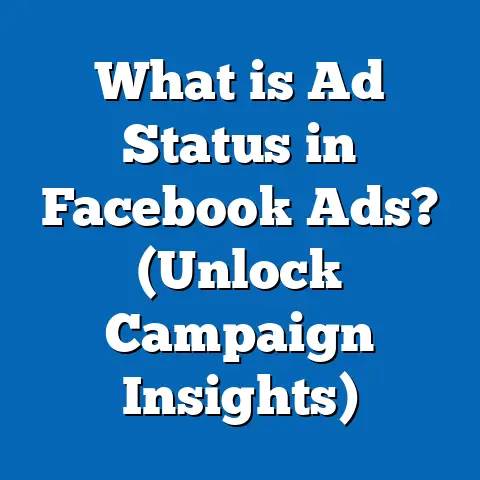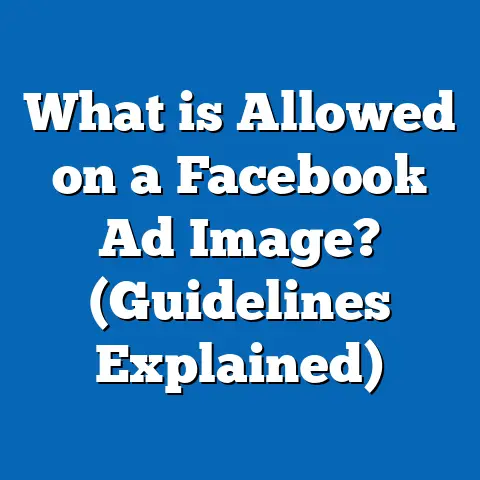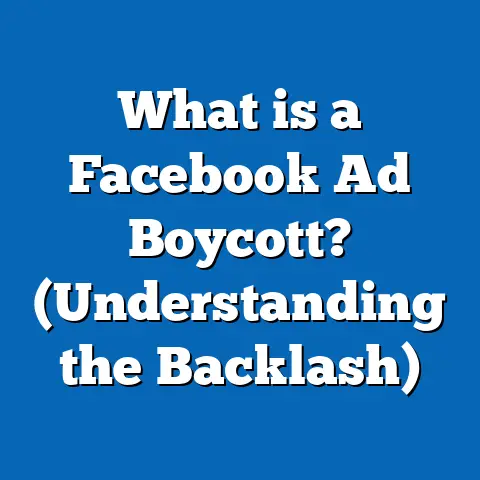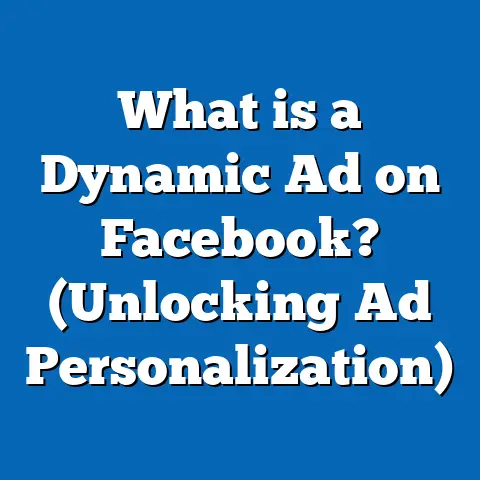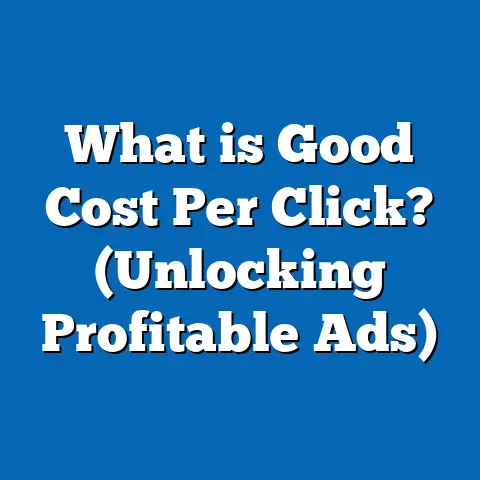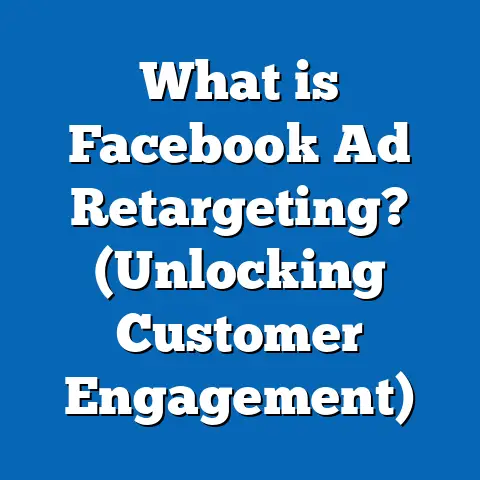What is a Good Response Rate on Facebook Ads? (Unlocking Success)
What is a Good Response Rate on Facebook Ads? (Unlocking Success)
Introduction: The Challenge of Measuring Facebook Ad Success
Imagine launching a Facebook ad campaign with high hopes—carefully crafted visuals, persuasive copy, and a precisely targeted audience—only to be met with ambiguous metrics that leave you questioning if your efforts paid off. How do you truly know if your audience is engaging? What qualifies as a “good” response rate on Facebook ads, especially when thousands of other advertisers compete for attention every second?
In today’s digital marketing landscape, where every dollar counts and competition is fierce, understanding what response rate signals real success can dramatically transform your ad strategy. It’s not just about impressions or clicks but about meaningful engagement that drives business growth.
Understanding Response Rate on Facebook Ads
What Is Response Rate?
Response rate in Facebook advertising refers to the percentage of people who take action after seeing your ad. These actions include clicking the ad link, liking the post, commenting, sharing, or any other form of interaction that shows engagement.
Simply put, it measures how effectively your ad motivates your audience to respond.
The Basic Formula
Response Rate=(Total EngagementsTotal Impressions)×100\text{Response Rate} = \left( \frac{\text{Total Engagements}}{\text{Total Impressions}} \right) \times 100
Where:
- Total Engagements = Sum of all interactions (likes, clicks, comments, shares)
- Total Impressions = Number of times the ad was shown (including multiple views by the same person)
For example, if your ad receives 500 likes, 100 comments, and 400 clicks from 50,000 impressions, your total engagements are 1,000. The response rate would be: 1,00050,000×100=2%\frac{1,000}{50,000} \times 100 = 2\%
This means 2% of all ad impressions resulted in some form of engagement.
Importance of Response Rate
Why should you care about response rate? Because it reveals how well your message resonates with your target audience. A high response rate often correlates with:
- Stronger brand awareness: When users engage with your ad, they are more likely to remember your brand.
- Better traffic quality: Engaged users tend to be more interested and more likely to convert.
- Lower advertising costs: Facebook rewards ads with higher engagement through better relevance scores and lower cost per engagement.
- Improved campaign insights: It helps you identify what works and what doesn’t for your audience.
Differentiating Response Rate from Other Metrics
Facebook advertising offers various metrics that sometimes cause confusion. Understanding how response rate relates to these can clarify your campaign evaluation.
Engagement Rate vs. Response Rate
- Engagement Rate typically measures total engagements divided by reach (the unique number of people who saw the ad). Engagement Rate=(Total EngagementsReach)×100\text{Engagement Rate} = \left( \frac{\text{Total Engagements}}{\text{Reach}} \right) \times 100
- Response Rate is based on impressions (total number of times the ad was displayed). Response Rate=(Total EngagementsImpressions)×100\text{Response Rate} = \left( \frac{\text{Total Engagements}}{\text{Impressions}} \right) \times 100
Since impressions can include multiple views by the same person, response rate tends to be lower than engagement rate. Both metrics are useful: engagement rate shows unique user reactions, while response rate reflects overall interaction frequency.
Click-Through Rate (CTR)
CTR is a focused metric showing the percentage of people who clicked your ad link: CTR=(ClicksImpressions)×100\text{CTR} = \left( \frac{\text{Clicks}}{\text{Impressions}} \right) \times 100
Clicks are a subset of engagements and are often used as a proxy for interest in the product or service being advertised.
Industry Benchmarks: What Constitutes a Good Response Rate?
Comprehensive Industry Data
Knowing average response rates by industry helps set realistic goals for your campaigns. Here is aggregated data sourced from multiple studies including WordStream’s Facebook Ads Benchmarks Report (2023), AdEspresso data, and internal agency analyses.
| Industry | Average Response Rate (%) | Typical Engagement Types |
|---|---|---|
| Retail & E-commerce | 1.5 – 3.5 | Clicks, likes, shares |
| Technology | 1.0 – 2.5 | Clicks, video views |
| Finance & Insurance | 0.5 – 1.8 | Clicks, form submissions |
| Education | 0.8 – 2.0 | Clicks, comments |
| Health & Wellness | 1.2 – 3.0 | Likes, shares |
| Consumer Services | 1.0 – 2.2 | Clicks, shares |
Note: These averages represent typical ranges seen in campaigns targeting broad audiences using standard ad formats.
What Is Considered a Good Response Rate?
- Excellent (>3%): Ads that strike a chord with the audience through perfect targeting and compelling creatives.
- Good (1.5% – 3%): Well-performing campaigns with solid targeting and creative execution.
- Average (~1%): Functional campaigns that may need optimization.
- Below Average (<1%): Campaigns requiring immediate review of targeting, creative quality, or offer relevance.
Nuances in Evaluating Response Rates
- Campaign objective matters: Awareness campaigns may have lower CTR but higher share/comment rates.
- Ad format influences engagement: Video ads generally get higher response rates compared to image ads.
- Audience size: Smaller, highly targeted audiences tend to yield better response rates than broad audiences.
- Placement differences: Ads in Stories often outperform ads in right-hand columns in terms of engagement.
Factors Affecting Facebook Ad Response Rates
Understanding what influences response rates helps you optimize campaigns effectively.
Audience Targeting
The more precise your targeting, the higher your response rate tends to be.
Targeting Options Include:
- Demographics (age, gender, location)
- Interests and hobbies
- Behaviors (recent purchases, device usage)
- Custom Audiences (website visitors, email lists)
- Lookalike Audiences (similar profiles to your best customers)
Example: A luxury watch brand targeting users who follow high-end fashion pages will get better engagement than one targeting all men aged 25-45.
Ad Creative Quality
Creative elements directly impact user engagement:
- Visual appeal: High-resolution images or professionally produced videos catch attention.
- Clear messaging: Simple headlines and calls-to-action (CTAs) reduce confusion.
- Relevance: Tailor content to audience interests and pain points.
Example: An ad showing a before/after transformation for a skincare brand often drives higher comments and shares than generic product shots.
Ad Placement
Facebook offers various placements including Feed, Stories, Marketplace, In-stream videos, and Audience Network.
- Feed ads usually have broad reach but moderate engagement.
- Stories ads generate higher engagement but shorter viewing time.
- In-stream video ads work well for mid-roll placements within video content.
Choosing placements based on your creative format and objective optimizes response rates.
Time and Frequency
Showing ads too many times to the same user leads to fatigue and declining engagement.
- Ideal frequency ranges between 1.5 and 3 exposures per user.
- Track frequency metrics in Ads Manager.
Adjusting frequency caps or rotating creatives can maintain user interest over time.
Case Study: How Targeting Optimization Boosted Response Rates by 300%
Client Background
A mid-sized online apparel retailer was struggling with low engagement on new product launch ads. The initial campaign used broad targeting across males and females aged 18-45 nationwide.
Initial Results
- Impressions: 200,000
- Engagements: 1,400
- Response Rate: 1,400200,000×100=0.7%\frac{1,400}{200,000} \times 100 = 0.7\% (Below industry average)
Strategy for Improvement
- Audience Segmentation: Created custom audiences from previous purchasers and website visitors.
- Lookalike Audiences: Developed based on top customers.
- Creative Testing: Introduced video ads showcasing new arrivals instead of static images.
- Placement Optimization: Focused on Feed and Stories instead of Audience Network.
- Frequency Management: Limited exposure to max 2 times per user per week.
Outcome After Optimization
- Impressions: 150,000
- Engagements: 4,200
- Response Rate: 4,200150,000×100=2.8%\frac{4,200}{150,000} \times 100 = 2.8\% (Excellent)
CTR improved by over 40%, while cost per engagement dropped by 25%.
This case highlights how refined targeting combined with creative enhancements dramatically improves response rates.
Comparing Facebook Ads Response Rates With Other Platforms
Understanding how Facebook performs against other platforms helps set expectations and allocate budgets wisely.
| Platform | Average Response Rate (%) | Key Characteristics |
|---|---|---|
| 1 – 3 | Extensive targeting; large global audience | |
| 1.5 – 4 | Visual-first; younger demographics | |
| 0.5 – 1.5 | B2B focus; high-value lead generation | |
| 0.5 – 1 | Real-time conversations; brief content | |
| Google Ads | Varies widely | Intent-driven; search ads have high CTR |
Why Facebook Stands Out
Facebook combines extensive demographic and behavioral data with diverse ad formats that cater to both B2C and certain B2B sectors. Its huge user base allows for granular segmentation which often results in higher engagement compared to platforms like LinkedIn or Twitter.
Advanced Tips To Improve Your Facebook Ads Response Rate
To consistently achieve high response rates requires evolving strategies:
Use Video Ads Effectively
Video ads attract more attention and sustain viewer interest longer than static images.
Best Practices:
- Keep videos under 15 seconds for maximum retention.
- Use captions for viewers watching without sound.
- Include a clear CTA early.
According to Facebook data (2024), video ads have up to a 30% higher engagement rate than image-based ads.
Leverage Retargeting Campaigns
Retargeting focuses on users who have interacted with your brand but haven’t converted yet.
Benefits include:
- Higher conversion likelihood due to prior awareness.
- Lower cost per engagement compared to cold audiences.
Use sequential messaging where initial retargeting ads focus on education and later ones push conversion offers.
Experiment with Multiple Ad Formats
Rotate different formats such as carousel ads (multiple images), collection ads (product catalogs), and instant experience ads (full-screen mobile experiences).
Testing reveals which format resonates best with your audience segment.
Optimize for Mobile Users
With over 90% of Facebook users accessing via mobile devices:
- Ensure fast loading landing pages.
- Use vertical video formats suitable for mobile viewing.
- Simplify CTAs for one-tap actions like “Shop Now” or “Sign Up.”
How To Track And Analyze Your Response Rate Effectively
Accurate tracking informs smarter decisions.
Use Facebook Ads Manager Metrics
Key metrics include:
| Metric | Why It Matters |
|---|---|
| Impressions | Volume of ad exposure |
| Reach | Unique users exposed |
| Engagements | Total interactions |
| CTR | Interest level in clicking |
| Frequency | Number of exposures per user |
| Conversion Rate | Percentage completing desired action |
Track trends over time rather than snapshots for meaningful insights.
Employ UTM Parameters For Deeper Tracking
Add UTM parameters to links directing traffic from Facebook ads to your website. This allows integration with Google Analytics or other tools for:
- Campaign source
- Medium
- Name tracking
- Behavior analysis after click
This data helps connect engagement to actual business outcomes like sales or sign-ups.
Apply A/B Testing Regularly
Test variations systematically:
- Different headlines or copy
- Alternative visuals or video lengths
- Diverse targeting segments
- Varying CTAs
Facebook’s split testing tools streamline this process and provide statistically significant results.
Practical Examples: Calculating And Interpreting Response Rate In Depth
Example 1: Calculating Response Rate With Multiple Engagement Types
Suppose you run an awareness campaign with these stats after one week:
| Engagement Type | Count |
|---|---|
| Likes | 800 |
| Comments | 200 |
| Shares | 150 |
| Link Clicks | 350 |
| Total Impressions | 75,000 |
Calculate total engagements: 800+200+150+350=1,500800 + 200 + 150 + 350 = 1,500
Response rate: 1,50075,000×100=2%\frac{1,500}{75,000} \times 100 = 2\%
Interpretation:
A 2% response rate indicates strong audience interest. However, analyzing which type of engagement dominates can guide next steps—for example, low clicks but high likes suggest curiosity but weak call-to-action effectiveness.
Latest Trends Impacting Facebook Ads Response Rates (2025 Update)
Privacy Changes And Data Access Challenges
New privacy regulations like GDPR and CCPA alongside platform updates such as Apple’s iOS privacy changes have limited third-party data tracking capabilities. This impacts targeting precision and attribution accuracy.
Advertisers are adapting by:
- Using first-party data more effectively.
- Investing in contextual targeting over behavioral.
- Leveraging Facebook’s aggregated event measurement framework.
Increased Use Of AI In Ad Creation And Optimization
Facebook’s AI-powered tools now assist advertisers by automatically generating creatives based on best-performing elements and optimizing bidding strategies dynamically for maximum engagement.
Early adopters report up to a 20% increase in response rates using AI-driven optimization.
Growing Importance Of Short-form Video Content
Formats like Reels have exploded in popularity due to their quick consumption style favored by younger demographics. Ads integrated into Reels see higher organic reach and better engagement compared to traditional feed ads.
Summary And Next Steps To Unlock Success With Your Facebook Ads
Key Takeaways:
- A good response rate is context-dependent but typically ranges from around 1% up to above 3%.
- Precise targeting combined with high-quality creatives significantly boosts engagement.
- Regular monitoring of relevant metrics is essential for ongoing optimization.
- Incorporating video content and retargeting strategies can dramatically improve response rates.
- Staying current on industry trends like privacy changes and AI tools ensures campaigns remain effective.
Next Steps For Marketers And Business Owners:
- Audit Your Current Campaigns: Use the formulas and benchmarks provided to evaluate existing response rates.
- Refine Your Targeting: Leverage custom and lookalike audiences for precision reach.
- Invest In Video Content: Test short-form videos optimized for mobile platforms.
- Implement Retargeting: Re-engage warm audiences through layered messaging sequences.
- Continuously Test & Optimize: Use A/B testing regularly to find winning combinations.
- Track Deeply With UTM Parameters: Connect ad engagements to real business outcomes via analytics tools.
- Stay Informed: Follow latest Facebook updates around privacy and AI enhancements to adapt strategies promptly.
By understanding what makes a good response rate on Facebook Ads and applying these detailed strategies consistently, you will unlock sustained advertising success that drives measurable growth for your business.

